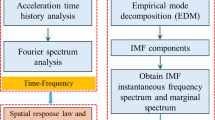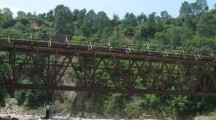Abstract
The study aims to determine the variation in the behaviour of different downstream and upstream nodes before and after retrofitting of an old steel truss bridge. The modal frequencies obtained from the vibration response signals are used to determine the improvement in the intactness of various nodes of the bridge. In this study, the Hilbert transform (HT) is applied in combination with modal frequency resolution enhancing signal processing techniques such as Fast Fourier transform (FFT), Multiple Signal Classification (MUSIC) algorithm, Estimation of signal parameters via rotational invariance (ESPRIT) for addressing the issues of additional noise present in the collected vibration response signals. The outcomes of the proposed methodology are compared for before and after retrofitting to observe the improved behaviour of different nodes of the bridge. The concept of sliding window ESPRIT is also applied to observe the variation of the modal frequencies at different nodes of the bridge. The application of HT-ESPRIT showed more robust, denoised and accurate outcomes than HT-MUSIC and HT-FFT techniques. The deficient nodes of the bridge are accurately identified through the outcomes of sliding window-ESPRIT technique.


















Similar content being viewed by others
Abbreviations
- \(A_{i}\) :
-
Complex amplitude
- AR:
-
Autocorrelation
- a(t):
-
Instantaneous amplitude
- C y :
-
Correlation matrix
- d :
-
Two submatrices distance
- \(e^{H} \left( {f_{i} } \right)\) :
-
Signal vector
- \({\text{e}}^{ - i\omega t}\) :
-
Complex exponentials
- e n :
-
White noise
- \({\text{e}}^{{j2\pi f_{k} }}\) :
-
Eigenvalue exponentials
- Hz:
-
Hertz
- H :
-
Hermitian transpose
- \(H\left[ {u\left( t \right)} \right]\) :
-
Hilbert transform (HT)
- \(I_{N - 1}\) :
-
Identity matrix having order of (N − 1)
- \(Q^{{{\text{MUSIC}}}} \left( f \right)\) :
-
MUSIC pseudospectrum
- \(S_{{{\text{sub}}}}\) :
-
Subspace matrices
- S :
-
Eigenvector matrix
- U :
-
Fourier transform operator
- u(t):
-
Sample signal
- \(V_{m + 1}\) :
-
Noise eigenvector
- \(\omega \left( t \right)\) :
-
Instantaneous frequency
- \(\theta \left( t \right)\) :
-
Instantaneous phase\({\theta \left( t \right) }\)
- \(\left( \cdot \right)^{H}\) :
-
Hermitian operator
- \(\varphi\) :
-
Eigen matrix
- \(\sigma^{2}\) :
-
Variance
References
Biezma MV, Schanack F (2007) Collapse of steel bridges. J Perform Constr Facil 21(5):398–405
Nasr A, Björnsson I, Honfi D, Larsson Ivanov O, Johansson J, Kjellström E (2019) A review of the potential impacts of climate change on the safety and performance of bridges. Struct Infrastruct Eng 16(4):1–21
Chi JH, Peng PC (2020) Study of the structural safety assessment of steel bridge subjected in post-fire. Constr Build Mater 247(6):1–8
Walia SK, Vinayak HK, Kumar A, Parti R (2012) Nodal disparity in opposite trusses of a steel bridge: a case study. J Civ Struct Health Monit 2(3–4):175–185
Gattulli V, Chiaramonte L (2005) Condition assessment by visual inspection for a bridge management system. Comput Aided Civ Infrastruct Eng 20(2):95–107
Brownjohn JMW, De SA, Helmut YX, Emin WA (2011) Vibration-based monitoring of civil infrastructure: challenges and successes. J Civ Struct Health Monit 1(3–4):79–95
Moughty JJ, Casas JR (2017) A state of the art review of modal-based damage detection in bridges: development, challenges, and solutions. Appl Sci 7(5):1–24
Modares M, Waksmanski N (2013) Overview of structural health monitoring for steel bridges. Philos Trans R Soc A 18(3):187–191
Kim CW, Chang KC, Kitauchi S, McGetrick PJ (2016) A field experiment on a steel Gerber-truss bridge for damage detection utilizing vehicle-induced vibrations. Struct Health Monit 15(2):174–192
Górski P, Napieraj M, Konopka E (2020) Variability evaluation of dynamic characteristics of highway steel bridge based on daily traffic-induced vibrations. Measurement 164(11):1–37
Yang YB, Xu H, Zhang B, Xiong F, Wang ZL (2020) Measuring bridge frequencies by a test vehicle in non-moving and moving states. Eng Struct 203(1):1–11
Ratcliffe C, Heider D, Crane R, Krauthauser C, Keun M, Gillespie JW (2008) Investigation into the use of low cost MEMS accelerometers for vibration based damage detection. Compos Struct 82(1):61–70
Sekiya H, Kubota K, Miki C (2018) Simplified portable bridge weigh-in-motion system using accelerometers. J Bridge Eng 23(1):1–15
Bearing LS, Caesarendra W (2017) A review of feature extraction methods in vibration-based condition monitoring and its application for degradation trend estimation of low-speed slew bearing. Machines 5(4):1–28
Yanez-Borjas JJ, Valtierra-Rodriguez M, Camarena-Martinez D, Amezquita-Sanchez JP (2020) Statistical time features for global corrosion assessment in a truss bridge from vibration signals. Measurement 160(8):1–13
Jin Z, Li G, Pei S, Liu H (2017) Vehicle-induced random vibration of railway bridges: a spectral approach. Int J Rail Transp 5(4):191–212
Assessment D, Based B, Frequencies MN (2017) Damage assessment in bridges based on measured natural frequencies. Int J Struct Stab Dyn 17(02):1–20
Nagarajaiah S, Basu B (2009) Output only modal identification and structural damage detection using time frequency and wavelet techniques. PLoS ONE 8(4):583–605
Bayissa WL, Haritos N, Thelandersson S (2008) Vibration-based structural damage identification using wavelet transform. Mech Syst Signal Process 22(5):1194–1215
Zhang Y, Li J (2006) Wavelet-based vibration sensor data compression technique for civil infrastructure condition monitoring. J Comput Civil Eng 20(6):390–399
Kankanamge Y, Hu Y, Shao X (2020) Application of wavelet transform in structural health monitoring. Earthq Eng Eng Vib 19(2):515–532
Mahato S, Chakraborty A (2019) Sequential clustering of synchrosqueezed wavelet transform coefficients for efficient modal identification. J Civ Struct Health Monit 9(2):1–21
Assous S, Boashash B (2012) Evaluation of the modified S-transform for time-frequency synchrony analysis and source localisation. J Adv Signal Process 49(1):1–18
Amini Tehrani H, Bakhshi A, Akhavat M (2019) An effective approach to structural damage localization in flexural members based on generalized S-transform. Scientiairanica 26(6):3125–3139
Chen B, Zhao S, Li P (2014) Application of Hilbert–Huang transform in structural health monitoring: a state-of-the-art review. Math Probl Eng 2014(2):1–22
Tan C, Uddin N (2020) Hilbert transform based approach to improve extraction of “drive-by” bridge frequency. Smart Struct Syst 25(3):265–277
Tan C, Uddin N, Obrien EJ, McGetrick PJ, Kim CW (2019) Extraction of bridge modal parameters using passing vehicle response. J Bridge Eng 24(9):1–15
Pan H, Azimi M, Yan F, Lin Z, Asce M (2018) Time-frequency-based data-driven structural diagnosis and damage detection for cable-stayed bridges. J Bridge Eng 23(6):1–22
Mahato S, Vinay M, Arunasis T (2017) Combined wavelet-Hilbert transform based modal identification of road bridge using vehicular excitation. J Civ Struct Health Monit 7(1):29–44
Perez-Ramirez CA, Machorro-Lopez JM, Valtierra-Rodriguez M, Amezquita-Sanchez JP, Garcia-Perez A, Camarena-Martinez D, Romero-Troncoso RDJ (2020) Location of multiple damage types in a truss-type structure using multiple signal classification method and vibration signals. Mathematics 8(6):932–948
Camarena-Martinez D, Amezquita-Sanchez JP, Valtierra-Rodriguez M, Romero-Troncoso RJ, Osornio-Rios RA, Garcia-Perez A (2014) EEMD-MUSIC-based analysis for natural frequencies identification of structures using artificial and natural excitations. Sci World J 2014(2):1–12
Sanjay A, Soumya RM, Vineeta A (2015) Bearing fault detection using Hilbert and high frequency resolution techniques. IETE J Res 61(2):99–108
Amezquita-Sanchez JP, Adeli H (2016) Signal processing techniques for vibration-based health monitoring of smart structures. Arch Comput Method E 23(1):1–15
Shokravi H, Shokravi H, Bakhary N, Heidarrezaei M, Rahimian Koloor SS, Petrů M (2020) Vehicle-assisted techniques for health monitoring of bridges. Sensors 20(12):1–29
Wen H, Guo S, Teng Z, Li F, Yang Y (2014) Frequency estimation of distorted and noisy signals in power systems by FFT-based approach. IEEE Trans Power Syst 29(2):765–774
Saad C, Baghouri M, Hajraoui A (2014) Performance analysis of faults detection in wind turbine generator based on high-resolution frequency estimation methods. Syst Control 5(4):139–148
Mohammadi L (2013) Performance analysis of different frequency estimation methods in GNSS-RO receivers with open loop tracking. Modares J Electr Eng 13(2):26–39
Jain SK, Member S, Singh SN, Member S (2012) Exact model order ESPRIT technique for harmonics and interharmonics estimation. IEEE Trans Instrum Meas 61(7):1915–1923
Chakkor S, Baghouri M, Hajraoui A (2015) High accuracy ESPRIT-TLS technique for wind turbine fault discrimination. Int J Electr Comput Electron Commun Eng 9(1):122–131
Garcia-perez A, Romero-troncoso RDJ, Cabal-yepez E, Osornio-rios RA (2011) The application of high-resolution spectral analysis for identifying multiple combined faults in induction motors. IEEE Trans Ind Electron 58(5):2002–2010
Trachi Y, Elbouchikhi E, Choqueuse V, Benbouzid M (2015) Stator current analysis by subspace methods for fault detection in induction machines. In: IECON 2015-41st annual conference of the IEEE industrial electronics society, pp 3479–3484
Qarib H, Adeli H (2016) A comparative study of signal processing methods for structural health monitoring. J Vibroengineering 18(4):2186–2204
Walia SK, Vinayak HK, Kumar A, Parti R (2015) Modal parametric changes in a steel bridge with retrofitting. Steel Compos Struct 19(2):385–403
Walia SK, Patel RK, Vinayak HK, Parti R (2015) Time–frequency and wavelet-based study of an old steel truss bridge before and after retrofitting. J Civ Struct Health Monit 5(4):397–414
IRC:6:2000 Standard specifications and code of practice for road bridges section-II load and stresses. New Delhi, India
Feldman M (2011) Hilbert transform in vibration analysis. Mech Syst Signal Process 25(3):735–802
Elbouchikhi E, Choqueuse V, Benbouzid M (2016) Induction machine bearing faults detection based on a multi-dimensional MUSIC algorithm and maximum likelihood estimation. ISA Trans 63(9):413–424
Kidar T, Thomas M, El BM, Guilbault R (2014) Mechanics industry control of phases by ESPRIT and WLSE methods for the early detection of gear cracks. Mech Ind 15(6):487–495
Gu IY, Bollen MHJ (2008) Estimating interharmonics by using sliding-window ESPRIT. IEEE Trans Power Deliv 23(1):13–23
Acknowledgements
The authors would like to thank the Himachal Pradesh Public Works Department, Government of Himachal Pradesh, India for allowing the National Institute of Technology, Hamirpur to conduct the experiment on the steel truss bridge in the state. The authors also thank Dr. Suresh Kumar Walia for providing necessary experimental data for further signal processing.
Funding
The authors declare that the present study is not funded by any source.
Author information
Authors and Affiliations
Corresponding author
Ethics declarations
Conflict of interest
The authors declare that there is no conflict of interest in the context of the publication of this manuscript. In addition, authors have carefully observed the ethical issues of plagiarism, misconduct, data falsification or any misconduct while developing the article.
Appendices
Appendix A

HT-root MUSIC plots of downstream nodes for before and after retrofitting of the steel truss bridge

HT-root MUSIC plots of upstream nodes for before and after retrofitting of the steel truss bridge
Appendix B

HT-ESPRIT plots of downstream nodes for before and after retrofitting of steel truss bridge

HT-ESPRIT plots of upstream nodes for before and after retrofitting of steel truss bridge
Rights and permissions
About this article
Cite this article
Sharma, A., Kumar, P., Vinayak, H.K. et al. Condition assessment of retrofitted steel truss bridge through fused Hilbert transform and frequency resolution enhancing techniques. Innov. Infrastruct. Solut. 6, 31 (2021). https://doi.org/10.1007/s41062-020-00396-7
Received:
Accepted:
Published:
DOI: https://doi.org/10.1007/s41062-020-00396-7




